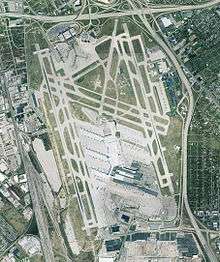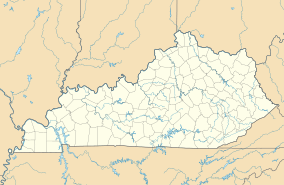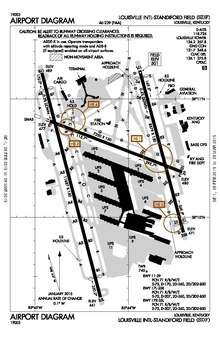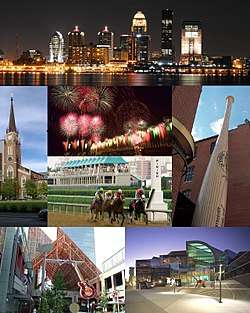Louisville International Airport
Louisville Muhammad Ali International Airport (IATA: SDF, ICAO: KSDF, FAA LID: SDF) is a civil-military airport in Louisville in Jefferson County, Kentucky. The airport covers 1,500 acres (6.1 km2)[1] and has three runways. Its IATA airport code, SDF, is based on the airport's former name, Standiford Field. It has no regularly-scheduled international passenger flights, but it is a port of entry, as it handles numerous international cargo flights.[4]
Louisville Muhammad Ali International Airport Standiford Field | |||||||||||||||||||
|---|---|---|---|---|---|---|---|---|---|---|---|---|---|---|---|---|---|---|---|
 | |||||||||||||||||||
| |||||||||||||||||||
| Summary | |||||||||||||||||||
| Airport type | Public | ||||||||||||||||||
| Owner/Operator | Louisville Regional Airport Authority (LRAA) | ||||||||||||||||||
| Serves | Louisville, Kentucky | ||||||||||||||||||
| Hub for | UPS Airlines | ||||||||||||||||||
| Elevation AMSL | 501 ft / 153 m | ||||||||||||||||||
| Coordinates | 38°10′27″N 085°44′11″W | ||||||||||||||||||
| Website | www | ||||||||||||||||||
| Map | |||||||||||||||||||
 SDF Location  SDF SDF (the United States) | |||||||||||||||||||
| Runways | |||||||||||||||||||
| |||||||||||||||||||
| Statistics (2019) | |||||||||||||||||||
| |||||||||||||||||||
Over 4.2 million passengers and over 5.7 billion pounds (2.89 million tons) of cargo passed through the airport in 2019.[5] It is also the third-busiest in the United States in terms of cargo traffic, and seventh-busiest for such in the world.[6] The National Plan of Integrated Airport Systems for 2011–2015 categorized it as a "primary commercial service" airport since it has over 10,000 passenger boardings (enplanements) per year.[7] As per Federal Aviation Administration records, the airport had 1,877,861 revenue enplanements in 2018, an increase of 11.46% from 1,684,738 in 2017.[8]
The airport is home to Worldport, the worldwide hub of UPS. The Kentucky Air National Guard's 123d Airlift Wing operates C-130 transport aircraft from the co-located Louisville Air National Guard Base.
On January 16, 2019, the Regional Airport Authority voted to change the name of the airport to Louisville Muhammad Ali International Airport in honor of the legendary boxing great and Louisville native Muhammad Ali.[9] On June 6, 2019, the airport unveiled its new logo, featuring "Ali's silhouette, arms up and victorious, against the background of a butterfly."[10]
History
Standiford Field was built by the Army Corps of Engineers in 1941 on a parcel of land south of Louisville that was found not to have flooded during the Ohio River flood of 1937. It was named for Dr. Elisha David Standiford, a local businessman and politician, who was active in transportation issues and owned part of the land. The field remained under Army control until 1947, when it was turned over to the Louisville Air Board for commercial operations.[11]
Until around 1947 Bowman Field was Louisville's main airport. For many years passenger traffic went through the small brick Lee Terminal at Standiford Field. Today's more modern and much larger facilities were built in the 1980s. Most of the Lee Terminal was later torn down.
When Louisville Muhammad Ali International Airport was built by the U.S. Army Corps of Engineers in 1941, it had one 4,000-foot (1,200 m) runway and was called Standiford Field. The airfield opened to the public in 1947 and all commercial service from Bowman Field moved to Standiford Field. American, Eastern, and TWA were the first airlines and had 1,300 passengers a week. The airlines used World War II barracks on the east side of the field until May 25, 1950, when a proper terminal opened. Lee Terminal could handle 150,000 passengers annually and included 6 new gates, which increased terminal space to 114,420 square feet (10,630 m2). The three runways (1, 6 and 11) were all 5000 ft.
The April 1957 Official Airline Guide shows 45 weekday departures on Eastern Airlines, 19 American, 9 TWA, 4 Piedmont and 2 Ozark. Scheduled jet flights (Eastern 720s to Idlewild) began in January–February 1962.
In 1970 the terminal again expanded; the main lobby was extended and the 33,000-square-foot (3,100 m2) Delta Air Lines concourse was built.[11]
The 1980s brought plans for a new terminal, the Louisville Airport Improvement plan (LAIP). Construction of a new landside terminal designed by Bickel-Gibson Associated Architects Inc. began, costing $35 million with capacity for nearly 2 million passengers in 1985.[12] Parallel runways, needed for expanded UPS operations, were part of the airport expansion.[11] Most of the improvements were completed in the 1990s and the airport was totally renewed.
During the 1990s, Southwest Airlines addition to the airport helped passenger boardings increase 97.3 percent. In 1995 the airport's name was changed from Standiford Field to Louisville International Airport. Around that time SDF opened the two new parallel runways: runway 17L/35R, 8,578 feet (2,615 m) long and runway 17R/35L, 11,887 feet (3,623 m); both are 150 feet (46 m) wide. The Kentucky Air National Guard moved its base to SDF with 8 military aircraft; a new UPS air mail facility, new corporate hangars, a 4 level parking garage and a new control tower were also added. A new FBO was added, run by Atlantic Aviation and managed by Michael Perry.
In 2005 a $26 million terminal renovation designed by Gensler Inc. was completed.[13]
On January 16, 2019, the Louisville Regional Airport Authority voted to rename the airport Louisville Muhammad Ali International Airport, after boxing legend Muhammad Ali, a Louisville native.[14]
Yearly passenger enplanements are about 1.9 million and are forecast to increase in the next 5 years. Louisville International is served by several airlines including Allegiant, American, Delta, Frontier, Southwest, United, FedEx, and UPS.[15]
Facilities

In the year ending May 31, 2019, the airport had 170,876 aircraft operations, an average of 468 per day: 77% airline, 15% air taxi, 7% general aviation, and 1% military. 29 aircraft were then based at this airport: 55% jet, 28 military, and 17% either single-engine or multi-engine.[1]
Terminal
The Jerry E. Abramson Terminal is the airport's main commercial terminal. It consists of two floors with ground transportation and baggage claim services on the first; and ticketing, passenger drop off, and concourse access on the second.[16] There are 23 gates in the two concourses. These concourses are connected by a rotunda and connector that contains a unified security checkpoint located in the main section of the terminal.
Runways
Louisville Muhammad Ali International Airport has three concrete runways, two of which are parallel with one crosswind. The westernmost runway (17R/35L) is the longest of the three at 11,887 feet (3,623 m) and was extended in 2007 to accommodate larger aircraft flying nonstop to destinations as far away as the Pacific Rim and Asia.[17][18]
Cargo hub

Worldport is the worldwide air hub for UPS (United Parcel Service) located at the Louisville Muhammad Ali International Airport. Although UPS has had a hub at Louisville since 1980, the term was not used officially by the company until 2002, after a $1 billion, five-year expansion.[19] Previously, the project was named Hub 2000. The facility is currently the size of 5.2 million square feet (48 ha; 80 football fields) and capable of handling 115 packages a second, or 416,000 per hour.[20] With over 20,000 employees, UPS is one of the largest employers in both the city of Louisville and the Commonwealth of Kentucky as a whole. The facility, which serves all of the company's major international and domestic hubs, mainly handles express and international packages and letters.
A one-million-square-foot expansion was completed in spring 2006 to integrate heavy freight into the UPS system. The expansion was prefaced by the purchase of Menlo Worldwide Forwarding, formerly Emery Worldwide. The new facility, designated Worldport Freight Facility (HWP), went online in April 2006 and was the first of the company's regional hubs to begin integrating the Menlo volume into the system. Menlo's facility in Dayton, Ohio, was taken offline in June 2006.
In May 2006, UPS announced that for the third time in seven years it would significantly expand its Worldport hub, with a second billion-dollar investment. The second expansion was completed in April 2010, with the facility now measuring 5,200,000 square feet (480,000 m2), with a perimeter of 7.2 miles (11.6 km). The plan was for more than one million square feet to be added to its existing facility, with another 334,500-square-foot (31,080 m2) of space to be renovated with new technology and equipment. Worldport sorting capacity was to expand from 300,000 packages per hour to 416,000 packages per hour. Additionally, several ramps at the Louisville Muhammad Ali International Airport were to be built or altered bringing a total increase of just over 3,000,000 square feet (280,000 m2).
Airlines and destinations
Passenger
| Airlines | Destinations | Refs |
|---|---|---|
| Allegiant Air | Fort Lauderdale, Las Vegas, Orlando/Sanford, Punta Gorda (FL), St. Petersburg/Clearwater Seasonal: Charleston (SC) (begins May 22, 2020),[21] Destin/Fort Walton Beach, Myrtle Beach, New Orleans, Sarasota, Savannah | [22] |
| American Airlines | Charlotte, Dallas/Fort Worth, Los Angeles | [23] |
| American Eagle | Charlotte, Chicago–O'Hare, Dallas/Fort Worth, Miami, New York–LaGuardia, Philadelphia, Washington–National | [23] |
| Delta Air Lines | Atlanta | [24] |
| Delta Connection | Detroit, Minneapolis/St. Paul, New York–LaGuardia | [24] |
| Frontier Airlines | Denver Seasonal: Orlando | [22] |
| Southwest Airlines | Baltimore, Chicago–Midway, Dallas–Love, Denver, Houston–Hobby, Las Vegas, Orlando, Phoenix–Sky Harbor, Tampa Seasonal: Fort Lauderdale | [25] |
| United Express | Chicago–O'Hare, Denver, Houston–Intercontinental, Newark, Washington–Dulles | [26] |
Cargo
| Airlines | Destinations |
|---|---|
| Air Cargo Carriers | Charleston (WV), Decatur, Madison, Warsaw (IN), Traverse City (MI) |
| Ameriflight | Huntsville, Knoxville, Moline/Quad Cities, Peoria, Smyrna (TN), South Bend |
| FedEx Express | Cincinnati, Memphis, Roanoke |
| SkyLink Express | Hamilton (ON) |
| UPS Airlines | Albany (GA), Albany (NY), Albuquerque, Anchorage, Atlanta, Austin, Baltimore, Billings, Birmingham (AL), Bogotá, Boise, Boston, Buffalo, Burbank, Casablanca, Cedar Rapids, Charlotte, Chicago–O'Hare, Cleveland, Cologne/Bonn, Columbia (SC), Columbus–Rickenbacker, Dallas/Fort Worth, Denver, Des Moines, Detroit, Dubai, East Midlands, Fargo, Fort Lauderdale, Fort Myers, Fort Wayne, Greensboro, Greenville/Spartanburg, Hamilton (ON), Harrisburg, Hartford, Hong Kong, Honolulu, Houston–Intercontinental, Jackson (MS), Jacksonville, Kansas City, Knoxville, Lafayette, Lansing, Las Vegas, Little Rock, Long Beach, Los Angeles, Manchester (NH), McAllen, Memphis, Mexico City, Miami, Milwaukee, Minneapolis/St. Paul, Montréal–Mirabel, Newark, Newburgh, New Orleans, New York–JFK, Oakland, Oklahoma City, Omaha, Ontario, Orange County (CA), Orlando, Peoria, Philadelphia, Phoenix–Sky Harbor, Pittsburgh, Portland (OR), Providence, Raleigh/Durham, Richmond, Sacramento–Mather, St. Louis, Salt Lake City, San Antonio, San Bernardino, San Diego, San Jose (CA), San Juan, Seattle–Boeing, Seoul–Incheon, Shanghai–Pudong, Sioux Falls, Springfield (MO), Syracuse, Tampa, Tokyo–Narita, Toronto–Pearson, Tulsa, Vancouver, Campinas–Viracopos, Washington–Dulles, West Palm Beach |
Statistics
Top destinations
| Rank | City | Passengers | Carriers |
|---|---|---|---|
| 1 | Atlanta, Georgia | 347,780 | Delta |
| 2 | Charlotte, North Carolina | 157,940 | American |
| 3 | Chicago–O'Hare, Illinois | 157,210 | American, United |
| 4 | Dallas/Fort Worth, Texas | 137,730 | American |
| 5 | Baltimore, Maryland | 110,380 | Southwest |
| 6 | Chicago–Midway, Illinois | 105,360 | Southwest |
| 7 | Denver, Colorado | 97,210 | Frontier, Southwest, United |
| 8 | Detroit, Michigan | 76,010 | Delta |
| 9 | Houston–Intercontinental, Texas | 68,890 | United |
| 10 | New York–LaGuardia, New York | 68,290 | American, Delta |
Airline market share
| Rank | Airline | Passengers | Share |
|---|---|---|---|
| 1 | Southwest Airlines | 1,075,000 | 26.40% |
| 2 | Delta Air Lines | 690,000 | 16.94% |
| 3 | Republic Airlines | 618,000 | 15.16% |
| 4 | SkyWest Airlines | 271,000 | 6.64% |
| 5 | PSA Airlines | 255,000 | 6.25% |
| 6 | Other | 1,165,000 | 28.60% |
Annual traffic
| Year | Passengers | Year | Passengers |
|---|---|---|---|
| 2003 | 3,291,586 | 2013 | 3,404,080 |
| 2004 | 3,399,712 | 2014 | 3,355,811 |
| 2005 | 3,696,524 | 2015 | 3,359,472 |
| 2006 | 3,637,795 | 2016 | 3,346,545 |
| 2007 | 3,812,299 | 2017 | 3,474,340 |
| 2008 | 3,678,919 | 2018 | 3,866,057 |
| 2009 | 3,254,657 | 2019 | 4,239,064 |
| 2010 | 3,343,968 | 2020 | |
| 2011 | 3,392,745 | 2021 | |
| 2012 | 3,365,115 | 2022 |
Accidents and incidents
- On September 28, 1953, Resort Airlines Flight 1081, a Curtiss C-46 Commando leased from the USAF, crashed on landing at Louisville-Standiford Field when the aircraft ballooned slightly during the flare-out, causing a loss of control when it climbed to 300 feet and stalled. Out of the 41 on board, 22 passengers and 3 crew were killed. Failure of the left elevator during landing was the cause.[28]
See also
- Kentucky World War II Army Airfields
- Bowman Field
- UPS Airlines
- World's busiest airports by cargo traffic
- Transportation in Louisville, Kentucky
References
- FAA Airport Master Record for SDF (Form 5010 PDF). Federal Aviation Administration. effective November 15, 2012.
- "RITA | BTS | Transtats - Louisville, KY: Louisville International-Standiford Field (SDF)". March 2014. Archived from the original on July 14, 2014. Retrieved July 6, 2014.
- "Reports and Statistics". Louisville Regional Airport Authority. Archived from the original on April 6, 2015.
- "US Customs and Border Patrol". Archived from the original on October 30, 2012.
- "Louisville Regional Airport Authority Aviation Statistics" (PDF). December 2018. Archived from the original (PDF) on February 10, 2019. Retrieved February 9, 2019.
- "Table 2 – TOTAL CARGO TRAFFIC 2013 – Preliminary World Airport Traffic and Rankings 2013 – High Growth Dubai Moves Up to 7th Busiest Airport – Mar 31, 2014". Airports Council International. March 31, 2014. Archived from the original on April 1, 2014. Retrieved July 6, 2014.
- "2011–2015 NPIAS Report, Appendix A" (PDF). faa.gov. Federal Aviation Administration. October 4, 2010. Archived from the original (PDF, 2.03 MB) on September 27, 2012.
- "Calendar Year 2018 Final Revenue Enplanements at All Airports" (PDF, 2.9 MB). faa.gov. Federal Aviation Administration. October 9, 2019. Retrieved October 17, 2019.
- "Archived copy" (PDF). Archived from the original (PDF) on January 22, 2019. Retrieved January 21, 2019.CS1 maint: archived copy as title (link)
- Ladd, Sarah (June 7, 2019). "Louisville's renamed Muhammad Ali International Airport debuts logo". usatoday.com. Louisville Courier Journal. Retrieved June 7, 2019.
- "History". Louisville International Airport. Archived from the original on August 18, 2016. Retrieved August 9, 2016.
- "Engineering News-Record". 209. McGraw-Hill. 1982. Archived from the original on July 8, 2014. Retrieved June 14, 2012. Cite journal requires
|journal=(help) - Adams, Brent (June 17, 2002). "Capital projects at Louisville Airport proceed; officials keep eye on security costs". Louisville Business First. archives.californiaaviation.org. Archived from the original on March 4, 2016. Retrieved July 26, 2016.
- Kobin, Billy (January 16, 2019). "Louisville is renaming its airport after Muhammad Ali". Courier Journal. courier-journal.com. Retrieved January 16, 2019.
- "Airlines". Louisville International Airport. Archived from the original on August 18, 2016. Retrieved August 9, 2016.
- Louisville Regional Airport Authority. "Terminal Map". Retrieved October 17, 2019.
- "Louisville Regional Airport Authority 20017 Annual Report" (PDF). Retrieved October 17, 2019.
- "Louisville Muhammad Ali International Airport". Retrieved October 17, 2019.
- "UPS Pressroom". November 6, 2002. Archived from the original on November 6, 2002.
- "UPS Worldport Facts". Archived from the original on December 3, 2013. Retrieved November 28, 2013.
- "Allegiant Announces Largest Service Expansion In Company History With 3 New Cities And 44 Nonstop Routes". Allegiant Airlines.
- "Archived copy". Archived from the original on February 12, 2019. Retrieved February 12, 2019.CS1 maint: archived copy as title (link)
- "Flight schedules and notifications". American Airlines. Archived from the original on February 2, 2017. Retrieved January 29, 2017.
- "FLIGHT SCHEDULES". Archived from the original on June 21, 2015. Retrieved January 7, 2017.
- "Check Flight Schedules". Archived from the original on February 2, 2017. Retrieved January 7, 2017.
- "Timetable". Archived from the original on January 28, 2017. Retrieved January 7, 2017.
- "Reports and Statistics". Retrieved February 17, 2020.
- Accident description for N66534 at the Aviation Safety Network. Retrieved on April 30, 2019.
External links
| Wikimedia Commons has media related to Louisville International Airport. |
- Louisville International Airport, official site
- Kentucky Air National Guard, official web site
- Standiford Field ANG / Louisville International Airport at GlobalSecurity.org
- Aerial image from USGS The National Map
- FAA Airport Diagram (PDF), effective April 23, 2020
- FAA Terminal Procedures for SDF, effective April 23, 2020
- Resources for this airport:
- AirNav airport information for KSDF
- ASN accident history for SDF
- FlightAware airport information and live flight tracker
- NOAA/NWS weather observations: current, past three days
- SkyVector aeronautical chart for KSDF
- FAA current SDF delay information

